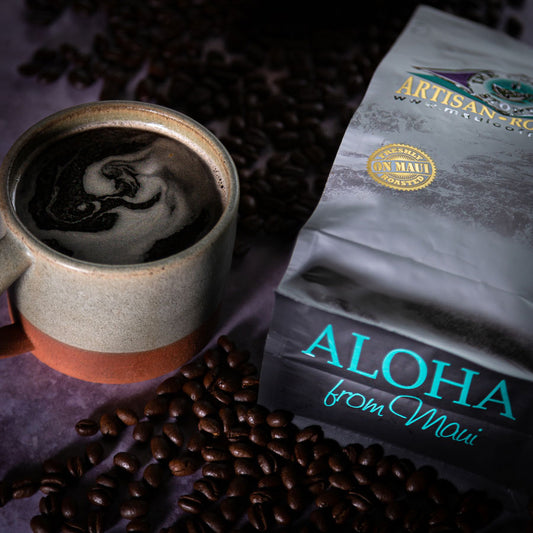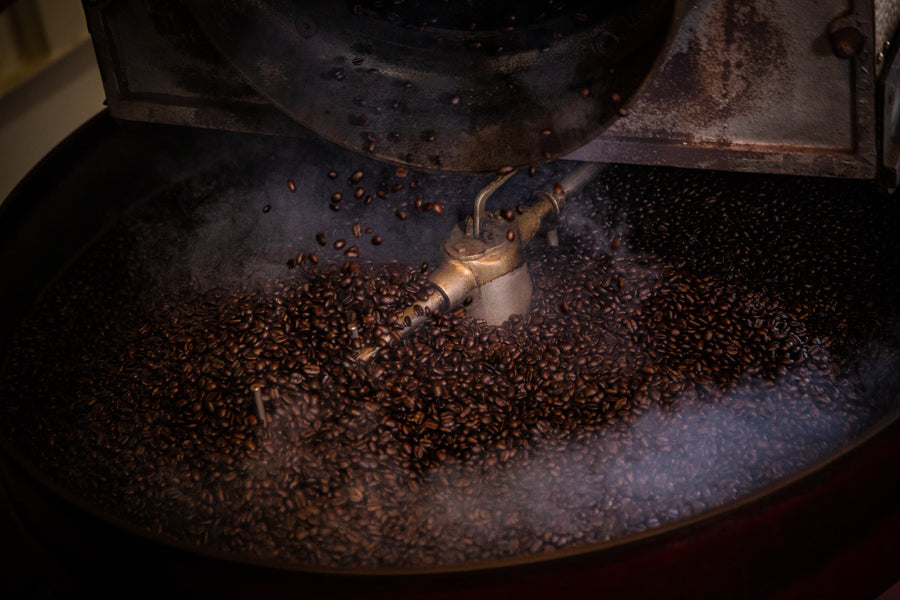There's no denying it...
...it's a digital world.
Our favorite songs are just so many 1's and 0's. Our favorite shows come to us on-demand via broadband connections. Even some the characters on those shows are built out of code.
And yet...
There is an abiding attraction to all things analog. We crave the crackle and pop of vinyl records... a warmth that the cold math of an MP3 cannot replicate. That ancient Polaroid somehow evokes emotions that a hard drive full of JPEGs never will.

This tension between the digital and the analog exists in the world of coffee roasting as well. Some roasters embrace a data-driven approach, mapping heat curves through sensitive thermocouples and sophisticated software...
Some of us, though, take the analog approach. Our roasts are guided by our senses, not our sensors... by aroma, not algorithm... by connection, not connectivity. We can't always quantify the magic of a wonderful roast, but we know it when we taste it.
Digital coffee roasters
The majority of coffee roasters nowadays employ a digital approach to their craft. Their roasting machines are equipped with one or more thermocouples - probes that give a real time digital temperature readout inside the machine's drum. The main thermocouple is located inside the bean mass - the area near the bottom of the drum where, depending on the rotational forces of the spinning drum, the roasting beans are most densely concentrated. There may be other thermocouples in other parts of the machine to assist with consistent preheating and to provide redundancy and safety features.

Coffee roasters may also employ sensors that monitor airflow, gas pressure and moisture. All of the data from these sensors is entered into a computer running roasting software. As the roast proceeds, this software maps a heat curve (more on that below). In some cases, the software can also control components of the roasting machine, effectively automating the roast.
Analog Coffee Roasters
Analog coffee roasting is not automated, nor is it mediated by real-time digital mapping of heat curves. Instead, it relies on skilled artisans who, in addition to monitoring temperature and timing, are using their senses of sight, smell and sound to achieve their desired roast profile. These artisan roasters need an intimate knowledge of their equipment as well as a deep familiarity with the particular coffee they're roasting at the time. Every roast is a measured progression of color and aroma, punctuated by audible cracks when the beans reach certain temperatures. Small on-the-fly adjustments based on these sensory inputs keep the roast on track. The consistency and quality of the roasting is based on the skill, care and experience of the artisan.

Software and Heat Curves
There are many different software platforms available to the digital coffee roaster. Some are proprietary systems that are integrated into the consoles of new roasting machines, others are aftermarket products that work with any laptop computer. The most widely used is called Cropster. In addition to mapping heat curves and allowing for roast automation, Cropster has open-source libraries to share different roast profiles and an interface to manage green coffee inventory.
So what is a heat curve? A heat curve is a graph of temperature over time. In digital roasting, the temperature is read from the thermocouple in the bean mass. It starts out high, reflecting the preheated 'charge temperature' of the roaster. It lowers quickly when room temperature beans are added at the start of the roast, bottoming out at the 'turning point'. At this point, the bean temperature and drum temperature have equalized, and both begin rising together. The speed at which the temperature increases is known as the 'rate of rise' (RoR) and is a crucial roasting metric. Early in the roast, RoR is relatively high, ideally decreasing as the roast progresses.

Roasters operating in both analog and digital paradigms monitor RoR. In analog roasting, the roaster manually reduces the heat over the course of the roast to keep the RoR in a downward trend. These adjustments are informed by readings of time and temperature, as well as sensory input from the beans themselves. In digital roasting, the name of the game is duplicating a desired heat curve on a very precise and granular level. Automation and machine learning make it possible to get very close to an exact match on a consistent basis.
Pros and Cons
Digital roasting has certain benefits and is indispensable for industrial-scale operations. Once a roastmaster creates a desired roast profile, it can be replicated readily. Less-experienced coffee roasters can be trained to execute these roasts. There is less opportunity for human error. And, there is a detailed digital record of every roast that can be referenced during cupping and quality control.
Furthermore, digital roasting is the putative future of the industry and the features, functionality and support are likely to improve over time. Analog roasting, in contrast, is a shrinking niche with less new equipment and fewer experienced artisans year after year.

Nonetheless, analog roasting is our passion here at The Coffee Store and it has notable advantages. Our artisan style is based on adapting, evolving and improving rather than replicating. No two roasts are the same - everything from bean moisture content to ambient weather can vary and affect the roast - and our sensory-based process is flexible and responsive. We're not interfacing with a computer screen, so we have more time to focus on the coffee. We're constantly tasting and comparing different roasts, and we bring a fresh perspective that's not tainted by a preconceived notion of heat curve analytics. We roast in small batches, and every single batch gets the full attention of a dedicated artisan.
Plus, we don't have to worry about our computer crashing.

Unplug... and Enjoy!
Whether your preferred coffee roaster is high-tech or low-tech, what really matters is the enjoyment you get from the coffee. It's not always easy in this information age, but sometimes it's nice to unplug while enjoying your coffee ritual. It's a digital world, but it's full of analog pleasures. Put on a record, crack open a paperback and pour a cup of artisan-roasted coffee. A Hui Hou!






